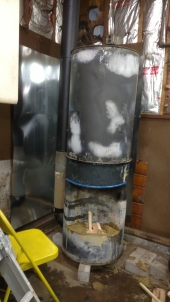
 4
4




“The most important decision we make is whether we believe we live in a friendly or hostile universe.”― Albert Einstein
 2
2




 1
1




Invasive plants are Earth's way of insisting we notice her medicines. Stephen Herrod Buhner
Everyone learns what works by learning what doesn't work. Stephen Herrod Buhner
 1
1





 1
1




How Permies works: https://permies.com/wiki/34193/permies-works-links-threads
My projects on Skye: The tree field, Growing and landracing, perennial polycultures, "Don't dream it - be it! "
 1
1




John Daley Bendigo, Australia The Enemy of progress is the hope of a perfect plan
Benefits of rainfall collection https://permies.com/t/88043/benefits-rainfall-collection
GOOD DEBT/ BAD DEBT https://permies.com/t/179218/mortgages-good-debt-bad-debt








J Hillman wrote:.......I expect it will get uncomfortably warm in there any time the sun shines. So eventually I want to bury drain tile in the floor then blow the air from the solar collector though the tile to heat up the floor so the floor acts as a thermal mass. In the summer the panels would be shaded by the roof overhang and possibly be covered with shade cloth.
I don't expect to keep it 60 degrees all winter but I do hope that by the time I get home from work in the afternoon the shop will be heated up and will continue to stay warm for several hours after dark. I would consider it a major success if I can keep the workshop above freezing ALL winter.
I have done a lot of experimenting with solar heat and I think my idea will work.
“The most important decision we make is whether we believe we live in a friendly or hostile universe.”― Albert Einstein
 1
1




John Weiland wrote:
I really like this vision, JH! I've been thinking of doing a similar thing on a smaller scale on the south side of an outbuilding that currently is uninsulated, but I would be curious about heating up a heat sink by day to be released into the outbuilding later in the day. Your idea of letting the sun charge up your thermal bank and then release it into your shop in the early evening sounds like a very doable scenario. With the deep frost that we get here (~5 feet), I'm also thinking of how best to protect the 'banked' heat with below-ground insulation, noting that insulation placed horizontally from the foundation of the heat collector might work as well as the same amount of insulation placed vertically. See https://framebuildingnews.com/below-grade-insulation-part-1/
Thanks and good luck with your build!




Country oriented nerd with primary interests in alternate energy in particular solar. Dabble in gardening, trees, cob, soil building and a host of others.

|
Well don't expect me to do the dishes! This ad has been cleaned for your convenience:
Switching from electric heat to a rocket mass heater reduces your carbon footprint as much as parking 7 cars
http://woodheat.net
|


